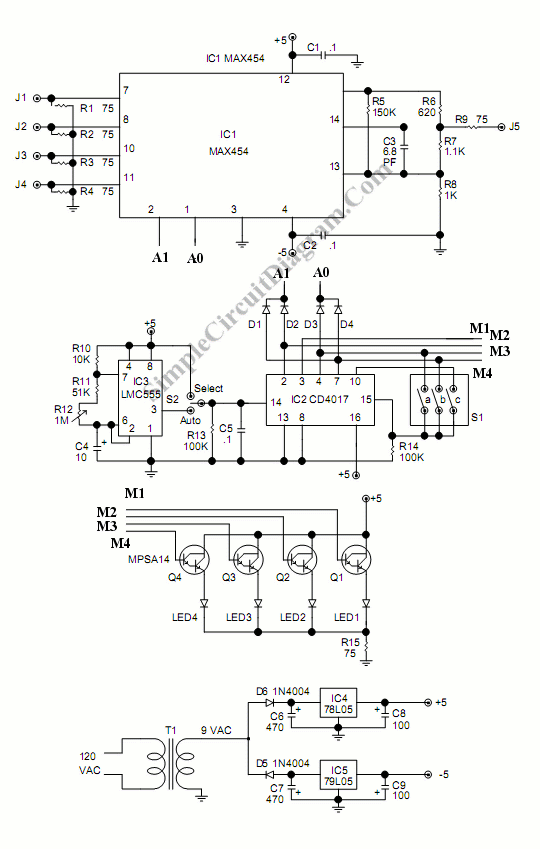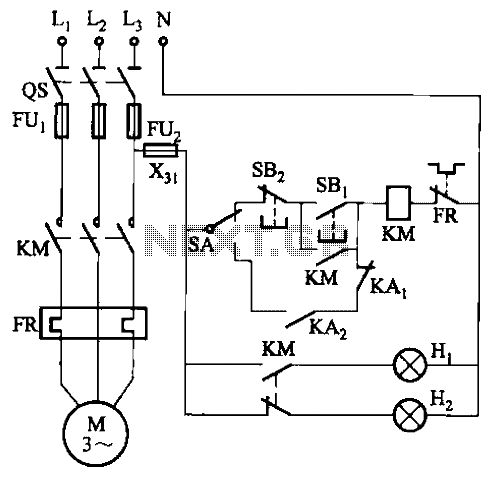
Automatic timer switch with ua741

When switch S1/2 is activated, it powers the circuit C1, which utilizes the UA741 operational amplifier for voltage comparison. Pin 3 serves as the non-inverting input, while pin 2 is the inverting input. The voltage at pin 3 is derived from a voltage divider formed by resistors R3 and R4, providing a reference voltage for comparison against the voltage at pin 2 and the voltage drop across capacitor C2. The combination of variable resistor VR1, resistor R1, and capacitor C2 is configured to introduce a delay, allowing for a longer time interval. The switch S1/1 is used to discharge C2 through resistor R10, enabling the circuit to restart when turned off. Both switches S1/1 and S1/2 operate under opposite conditions, while a 555 IC timer controls a relay switch, forming a straightforward timer circuit. This circuit employs the LM555 timer, an 8-pin integrated circuit, known for its accuracy in timing applications, adjustable via VR1. The circuit also incorporates a 2N4871 transistor to prevent surges that may occur during power interruptions, protecting electrical appliances from damage. Additionally, there is an OFF After Delay Switch Circuit utilizing a MOSFET to control a load. This circuit operates simply by pressing switch S1 to close the circuit, which activates an electric bell.
The circuit described encompasses multiple functionalities, primarily focusing on voltage comparison and timing operations. The UA741 operational amplifier is a versatile component, often used in analog applications for signal amplification and comparison. In this configuration, it is crucial for determining the conditions under which the relay is activated or deactivated based on the voltage levels at its inputs.
The voltage divider formed by R3 and R4 is essential for establishing a stable reference voltage at pin 3 of the UA741. The reference voltage is compared with the voltage at pin 2, which is influenced by the voltage drop across capacitor C2. The delay introduced by the combination of VR1, R1, and C2 ensures that the system can maintain its state for a predetermined period, effectively managing the timing of relay activation.
The use of the 555 timer IC is notable for its reliability and ease of use in timing applications. By adjusting VR1, the timing can be fine-tuned for specific requirements, making this circuit adaptable for various applications. The integration of the 2N4871 transistor serves a critical protective role, mitigating potential damage from voltage spikes during power cycling.
The inclusion of a MOSFET for the OFF After Delay Switch Circuit highlights the versatility of modern electronic components, allowing for efficient control of loads with minimal power loss. This aspect is particularly beneficial in applications where energy efficiency is paramount.
Overall, this circuit design exemplifies a well-thought-out approach to managing timing and voltage comparison tasks, ensuring both functionality and protection for connected devices.When the switch S1 / 2 power input to the circuit C1 No. ua741. To a voltage comparison circuit. The pin 3 is the noninverting pin. for pin 2 to pin inverting. The pin 3 was divided voltage from R3 and R4. Used as a reference voltage for comparing the voltage at Pin 2 And the voltage drop across C2. The VR1, R1 and C2 is set to delay. To set up a lon g time. I add the R1 and C2. The switch S1 / 1 to determine the C2 discharge through R10 out. To start new work while off. The switch S1 / 1 and S1 / 2 are in the same But working conditions are opposite. 555 IC Timer control relay SwitchThis is easy Timer circuit projects. Control by relay. It use IC 555. This the circuit sets the time to are simple one that interesting, because use IC LM555 Timer be 8 pin integrated circuits. But can set the time accurate can use by fine while VR1 [. ] Switch off delay circuit by 2N4871 This circuit prevents surges. From the opening is switched off or power failure. The damage to electrical appliances. The circuit will switch to use a short period before Power raising circuit to go. [. ] OFF After Delay Switch by MosfetThis is OFF After Delay Switch Circuit. It is use Mosfet control the work of LOAD get. By have the work is simple be press Switch (Close) and liberate (Open) S1 an electric bell will loud.
[. ] We aim to transmit more information by carrying articles. Please send us an E-mail to wanghuali@hqew. net within 15 days if we are involved in the problems of article content, copyright or other problems. We will delete it soon. 🔗 External reference
The circuit described encompasses multiple functionalities, primarily focusing on voltage comparison and timing operations. The UA741 operational amplifier is a versatile component, often used in analog applications for signal amplification and comparison. In this configuration, it is crucial for determining the conditions under which the relay is activated or deactivated based on the voltage levels at its inputs.
The voltage divider formed by R3 and R4 is essential for establishing a stable reference voltage at pin 3 of the UA741. The reference voltage is compared with the voltage at pin 2, which is influenced by the voltage drop across capacitor C2. The delay introduced by the combination of VR1, R1, and C2 ensures that the system can maintain its state for a predetermined period, effectively managing the timing of relay activation.
The use of the 555 timer IC is notable for its reliability and ease of use in timing applications. By adjusting VR1, the timing can be fine-tuned for specific requirements, making this circuit adaptable for various applications. The integration of the 2N4871 transistor serves a critical protective role, mitigating potential damage from voltage spikes during power cycling.
The inclusion of a MOSFET for the OFF After Delay Switch Circuit highlights the versatility of modern electronic components, allowing for efficient control of loads with minimal power loss. This aspect is particularly beneficial in applications where energy efficiency is paramount.
Overall, this circuit design exemplifies a well-thought-out approach to managing timing and voltage comparison tasks, ensuring both functionality and protection for connected devices.When the switch S1 / 2 power input to the circuit C1 No. ua741. To a voltage comparison circuit. The pin 3 is the noninverting pin. for pin 2 to pin inverting. The pin 3 was divided voltage from R3 and R4. Used as a reference voltage for comparing the voltage at Pin 2 And the voltage drop across C2. The VR1, R1 and C2 is set to delay. To set up a lon g time. I add the R1 and C2. The switch S1 / 1 to determine the C2 discharge through R10 out. To start new work while off. The switch S1 / 1 and S1 / 2 are in the same But working conditions are opposite. 555 IC Timer control relay SwitchThis is easy Timer circuit projects. Control by relay. It use IC 555. This the circuit sets the time to are simple one that interesting, because use IC LM555 Timer be 8 pin integrated circuits. But can set the time accurate can use by fine while VR1 [. ] Switch off delay circuit by 2N4871 This circuit prevents surges. From the opening is switched off or power failure. The damage to electrical appliances. The circuit will switch to use a short period before Power raising circuit to go. [. ] OFF After Delay Switch by MosfetThis is OFF After Delay Switch Circuit. It is use Mosfet control the work of LOAD get. By have the work is simple be press Switch (Close) and liberate (Open) S1 an electric bell will loud.
[. ] We aim to transmit more information by carrying articles. Please send us an E-mail to wanghuali@hqew. net within 15 days if we are involved in the problems of article content, copyright or other problems. We will delete it soon. 🔗 External reference





